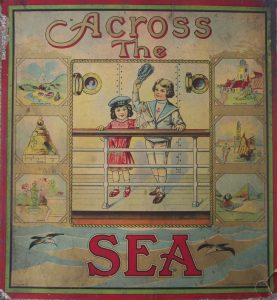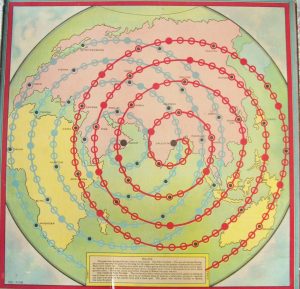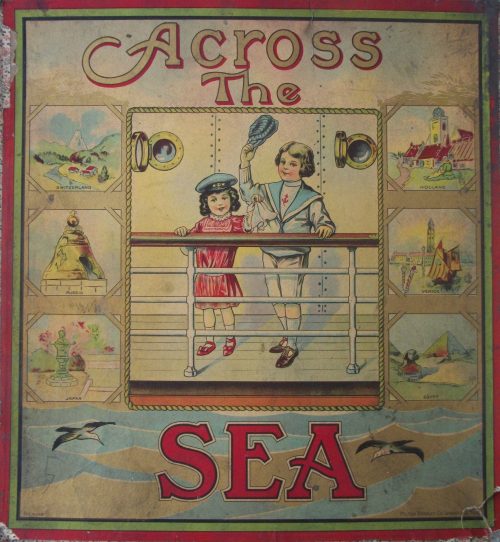 Across the Sea by Milton Bradley was published in the early 1900’s. Two intertwining red and blue spiral tracks take players ‘across the sea’ and through cities of the world. Produced at a time when everyday travel to the places depicted on the board was uncommon, the game helped players imagine themselves on an adventurous journey.
Across the Sea by Milton Bradley was published in the early 1900’s. Two intertwining red and blue spiral tracks take players ‘across the sea’ and through cities of the world. Produced at a time when everyday travel to the places depicted on the board was uncommon, the game helped players imagine themselves on an adventurous journey.
The box cover centrally displays two children, who are dressed of the time and are standing by the ship’s rail. They are ready to set sail. Six smaller images are shown along the sides. These varying scenes highlight important aspects of Switzerland, Russia, Japan, Holland, Venice, and Egypt. They are of places where the game’s voyage will take players on the inside board.
Like many games of the period, Across the Sea is a simple race style game. Two to four players could sit around a table, enjoy each other’s company, and leisurely play the game. The game took them to numerous cities across the sea, and today, one can imagine the players talking about the far off locations, like the pyramids, the Alps, and other spectacular spots, with awe.
To begin play, a person chooses a game piece to represent him on the board, and decides which spiraling track he would like to travel on; red or blue. The player with the highest roll of the dice goes first. Taking turns rolling the dice and moving their pieces accordingly, the players race to the center of the spirals. The first player to reach either Calcutta (on the red track) or Maskat (on the blue track) wins the game.
A few differently marked spaces on the board indicate special instructions for a player. They are as follows:

In a two player game, if a player lands on a black dotted space, he moves ahead four spaces. In a three to four player game, if a player lands on a black dotted space, he is considered on a ‘safety spot.’ During a three to four player game, if a player is overtaken by another player, and NOT sitting on a ‘safety spot’, then that player must move his piece back to the nearest space with a black dot.
In a two player game, if a player lands on a red or blue filled space by exact roll, that player must move back to the nearest black dotted space. The directions mention nothing concerning the red and blue spaces for a three or four player game, so the spaces are considered like any other.
The red spiral track passes through the cities, Brisbane, Yakutsk, Smyrna, Cairo, Adis Abeba, Tokyo, Mukden, Tomsk, Riad, Borneo Island, Shanghai, Irkutsk, Kabul, Hanoi, and finishes on Calcutta.
The blue spiral track passes through Windhoek, Dakar, Paris, St. Petersburg, Nankin, Sumatra Islands, Boma, Tripoli, Vienna, Mandalay, Khartum, Athens, Urumchi, Khelat, and finishes on Maskat.
The old Milton Bradley game is a collectible today, and if played, still takes players on a wondrous journey Across the Sea….but; it also takes players back in time.
Play a game today!

